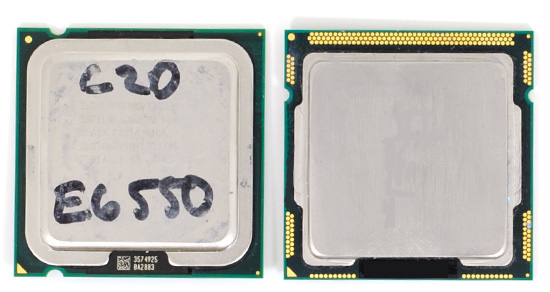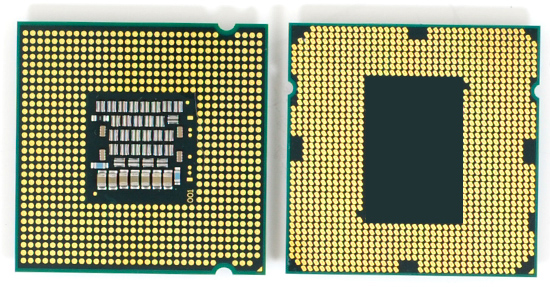The Lynnfield Preview: Rumblings of Revenge
by Anand Lal Shimpi on May 29, 2009 1:00 PM EST- Posted in
- CPUs
The First Lynnfield Sample
Let me preface this with the usual disclaimer. Intel did *not* supply me with this chip and it is most definitely pre-production silicon, not necessarily indicative of final, shipping performance.
With that out of the way, here is Lynnfield:

Lynnfield (front) vs. Bloomfield (back)

Core i7-Bloomfield (left) vs. Lynnfield (right)
It’s a lot smaller than the LGA-1366 Core i7, but compared to current Core 2 Quads it’s actually similar in size:

LGA-775 Core 2 Duo (left) vs. LGA-1156 Lynnfield (right)
Flipping the chips over you see that Lynnfield has a much higher pad density, enabling Intel to fit 1156 pads in about the same space as it fit 775 pads just a few years prior.

Core 2 (left) vs. Lynnfield (right)
Once more, I’ve blanked out all of the caps and other markings on the chip to protect the innocent.
The initial Lynnfield samples were all clocked at 2.13GHz with HT enabled. Turbo mode was also enabled but it too was a meager 2.26GHz regardless of how many cores were active. All of this was to enable motherboard manufacturers to test compatibility and performance of their P55 without giving away Lynnfield’s true performance.
Unfortunately this is the sample I tested with. Thankfully it was healthy enough for me to overclock the BLCK to 166MHz, resulting in a 2.66GHz frequency. Turbo mode was still stuck at a 1x increase over the stock frequency, so final Lynnfield performance should be much better in single and dual threaded apps than what you’ll see here today.
The results on the coming pages show three configurations. Lynnfield running at 2.13GHz with HT enabled, 2.66GHz with HT enabled and 2.66GHz with HT disabled. The latter is going to be the closest to actual Lynnfield performance (albeit still far away thanks the sample’s crippled turbo mode), the 2.66GHz with HT enabled just shows how much we gain from HT and the 2.13GHz chip is an experiment in seeing how low Intel could drop these things and still have a competitive part.
If you thought Nehalem needed Hyper Threading to be a strong performer, you were dead wrong.
Comments About Lynnfield's Readiness
The current rumors in the press are that Lynnfield is being held back in order to clear out excess Core 2 Quad inventory before it ships, because once this thing ships no one is going to want a Penryn anymore. Based on what I've seen, Lynnfield isn't ready just yet - it's not an artificial delay.
The motherboards are in rough shape, CF/SLI isn't working and we're still at very early revs of the CPU's silicon. While I think that the chip will be ready far in advance of its rumored September shipdate, the CPU and motherboards aren't yet.
The Test
Once more: the CPU we've tested here is pre-production silicon without all of its turbo modes enabled. I expect final, shipping performance to be higher in some cases.
| Motherboard: | Pre-release P55 Motherboard (Intel P55) Intel DX58SO (Intel X58) Gigabyte GA-MA790FX-UD5P (AMD 790FX) |
| Chipset: | Intel P55 |
| Chipset Drivers: | Intel 9.1.1.1012 (Intel) AMD Catalyst 8.12 |
| Hard Disk: | Intel X25-M SSD (80GB) |
| Memory: | Qimonda DDR3-1066 4 x 1GB (7-7-7-20) Corsair DDR3-1333 2 x 2GB (7-7-7-20) |
| Video Card: | eVGA GeForce GTX 280 |
| Video Drivers: | NVIDIA ForceWare 180.43 (Vista64) NVIDIA ForceWare 178.24 (Vista32) |
| Desktop Resolution: | 1920 x 1200 |
| OS: | Windows Vista Ultimate 32-bit (for SYSMark) Windows Vista Ultimate 64-bit |










95 Comments
View All Comments
Anand Lal Shimpi - Saturday, May 30, 2009 - link
P55 essentially has the same ICH feature set as P45. You get support for six SATA 3.0Gb/s ports, 12 USB 2.0 and PCIe 2.0.Intel's chipsets are actually what I use for all of my SSD tests and they work quite well. I wouldn't expect any different out of P55.
Remember that P55 is only the first Lynnfield chipsets, next year we'll see more. This chart speculates on some of the features of those (it also lists 14 USB instead of 12, I'm not sure which one is right):
http://img405.imageshack.us/img405/74/hkepcibexpea...">http://img405.imageshack.us/img405/74/hkepcibexpea...
Take care,
Anand
Drazick - Saturday, May 30, 2009 - link
I thought so...I hope someone will adopt the changes quickly.
It's about time to get rid of the BIOS and make room for speed improvements int the Flash chips (Both via the SATA 3 and USB 3).
Do you see in the horizon how long will it take before will see those features?
Thank you for the response.
Krogoth255 - Saturday, May 30, 2009 - link
I find it very funny when people make a huge fuss over a 2-10% difference in performance (i5 versus i7). It is sad that even budget CPUs are bloody overkill for majority of computer users.The bottom line is that i5 is going to be Intel's next big winner. It is the perfect Phenom II killer and an excellent successor to the Core 2 parts that it is replacing. I7 makes very little sense unless time is $$$$$.
PrinceGaz - Sunday, May 31, 2009 - link
Exactly. My nearly four-year old S939 Athlon 64 X2 still performs everything I do (with one exception) more than fast enough so the difference between the i5 and i7 would be irrelevant. I still think I'm at least a year or two from doing a new build (the only thing of any value at all in my current box I could reuse would be the graphics-card, a 640MB 8800GTS; most of the drives are parallel ATA, and the memory is of course DDR).Given that the one app where my current rig struggles is PCSX2 (a Playstation 2 emulator), it seems kind of silly to spend upwards of £500 for a new box simply to play PS2 console games, when I could probably buy a new PS2 console for under £100. Therefore debates over the relative merits of i5 and i7 which are both much faster are rather moot for me at the moment, and the vast majority of the PC buying public. It is nice to know how they compare though, and what their pros and cons are (the main con I see being the price of X58 mobos), so I'm thankful for this informative article on AT.
just4U - Saturday, May 30, 2009 - link
I don't quite understand why X58 boards are so expensive. At first we were complaining about ddr3 prices.. but they've come down to a managable point. While cheaper X58 solutions are starting to crop up it's still extremely high and I don't quite get why that is.With the memory controller integrated into the chip you'd think that the cost of the boards would be cheaper overall. That was one of Amd's main selling points (if I remember right) but for the i7 not the case.. the boards are priced incredibly high.
Anand Lal Shimpi - Saturday, May 30, 2009 - link
It's artificial. The boards are priced so high because Intel charges quite a bit of money for the X58 chipset. It's the cost of competition; if AMD had a true answer to i7 we'd have much more affordable i7 platforms all of the sudden :)Take care,
Anand
jmurbank - Sunday, May 31, 2009 - link
Chipset and processor prices are two different things. Neither are related to each other. Like all products, prices of chipsets is related to other chipsets competing at the same level. Since the X58 does not have any competitor, people have to pay a high premium for a complete i7 system. If nVidia is allowed to make a chipset for the i7 processor, we will see these high premium prices decrease. Since the i7 processor is designated as enthusiast setup, prices will still be at enthusiast pricing.just4U - Saturday, May 30, 2009 - link
You've had them on your test beds so you'd know better then I. Hell I haven't even gotten any hands on with the i7 since people here keep opting for the PII. Not that that's a bad thing, I am rather impressed with those overall just..Im beginning to realize the only way Im going to get my grubby little paws on a I7 is if I go out and build it for myself. Even I balk a little bit at the price tag of some of those boards but there are a few coming down the pipeline that look a little bit more reasonably priced.
Jabbernyx - Saturday, May 30, 2009 - link
EX58-UD3R = $150 from eWiz ;)goinginstyle - Saturday, May 30, 2009 - link
It is $185.99 at eWiz with a $15 rebate that will take two months to get for an end price of $170.99.